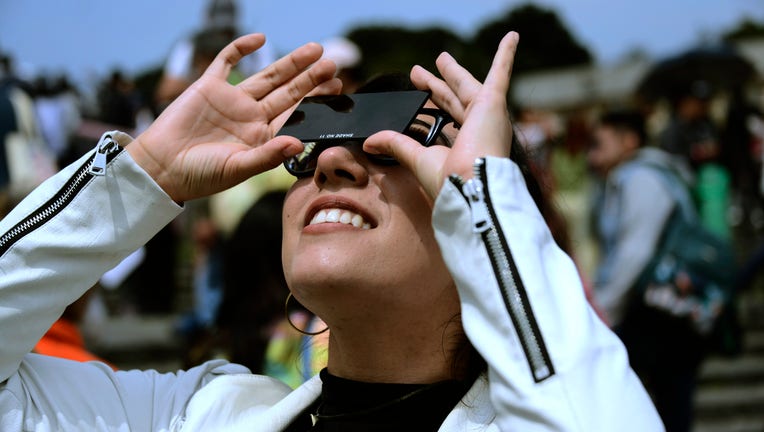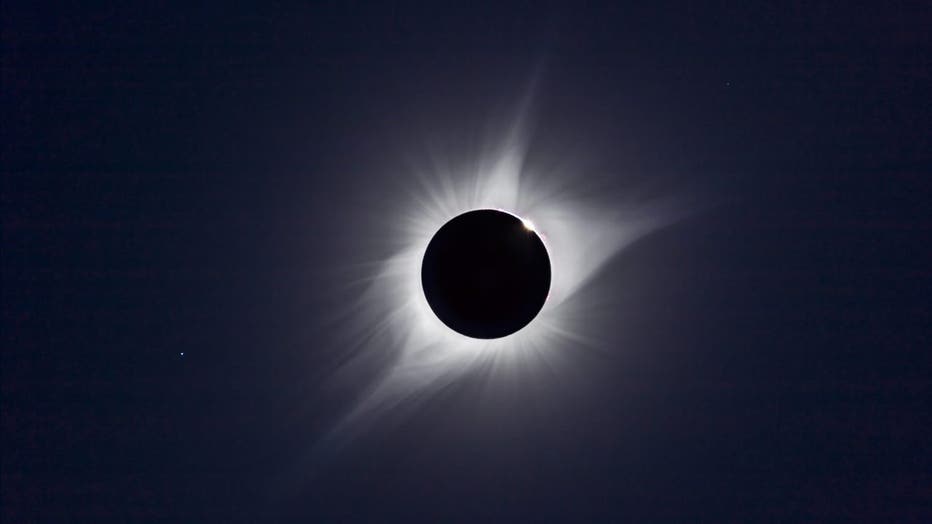The great April eclipse: All you need to know

October 14, 2023, Mexico City, Mexico: A young woman is seen watching the Annular Solar Eclipse with special sun filter glasses at the National Autonomous University of Mexico (UNAM). (Photo by Carlos Tischler/ Eyepix Group) (Photo credit should read
In just a few days, people across North America will get a chance to experience a compelling and infrequent astronomical event: a total solar eclipse. Read on for more details on the eclipse, how to watch it safely, tips to selecting the perfect viewing location and more.
When is the 2024 solar eclipse?
The 2024 total solar eclipse will occur on April 8.
Total solar eclipse path
The April 2024 solar eclipse will be visible, at least in part, to nearly everyone in the U.S. But the path of totality – where the moon will completely block the sun – is a 115-mile-wide region that stretches from southern Texas up through Ohio, then over to northern Maine.
Large cities in the path of totality include:
- Austin, Texas
- Dallas, Texas
- Little Rock, Arkansas
- Carbondale, Illinois
- Indianapolis, Indiana
- Cleveland, Ohio
- Buffalo, New York
- Plattsburgh, New York
- Presque Isle, Maine
The farther you are from that path, less and less of the sun will appear to be blocked.
What time is the solar eclipse?
Southern Texas will see the peak of totality first, around 1:30 p.m. Central Daylight Time. Then Dallas at 1:42 p.m., with the time getting later and later as the moon’s shadow moves north. Indianapolis will see the peak around 3:05 p.m. Eastern Daylight Time; Cleveland at 3:15 p.m., and northern Maine around 3:30 p.m.
However, it will take several hours for the moon to move across the sun, so the actual eclipse event will start just over an hour before the peak of totality, with more and more of the sun slowly being blocked.
How long is the solar eclipse?
Again, that depends on where you are. Those closest to the center of the path will see total darkness for about four minutes at the peak of totality.
But because the moon moves slowly across the sun’s path, the entire eclipse event – from when the moon first clips the sun until the time it clears – will last from 90 minutes to over two hours for those in the path of totality.
Where do I look for the solar eclipse?
The easiest way to know may be to step outside in the days leading up to the eclipse and see where the sun is during the afternoon.
MORE: How to get the best view of the solar eclipse
Early afternoon on April 8, the sun will be pretty high in the sky. As always, though, the further north you are, the lower in the sky the sun will appear.
For example, in Austin, the sun will be at 67 degrees up from the horizon at the peak of totality. Remember, 90 degrees is straight up, so 67 degrees is just over two-thirds up into the sky from the horizon.
In Cleveland, meanwhile, the sun will be slightly lower, at only 49 degrees – just over halfway up in the sky.
When is the next total solar eclipse?
After 2024, NASA says, the next total solar eclipse visible from any point in the contiguous United States will occur in 2044. Totality will only be visible from North Dakota and Montana.
The next total solar eclipse that will travel across the lower 48 states from coast to coast is in 2045.
Where can you see the eclipse?
The total eclipse will be visible along the path of totality, which runs on a northeastern diagonal from Mexico through Texas, Oklahoma, Arkansas, Missouri, Illinois, Kentucky, Indiana, Ohio, Pennsylvania, New York, Vermont, New Hampshire, and Maine, as well as parts of Tennessee and Michigan. All of the contiguous United States will experience a partial eclipse.
How can you watch the eclipse safely?
With a brief exception (it’s called totality – more on that below), it is very unsafe to look directly at an eclipse. Luckily, there are several ways to watch the progression of the eclipse before and after totality. Those methods include:
- Pinhole camera
- Colander (yes, really!)
- Eclipse glasses
- Handheld eclipse viewer
- Welding filter, shade 13 or 14
You’ll find more on these options below.
What does totality mean?
Totality in an eclipse is when the moon fully obscures the sun, allowing observers within the path of the moon's shadow to witness it. When totality occurs, the corona (the sun's outer atmosphere) becomes visible as a halo surrounding the moon. The day is plunged into twilight, stars and planets may become visible in the sky, and the temperature drops as much as 10 degrees. This period of totality is typically quite short – a few minutes, tops – but it can have a profound impact on those who experience it.
MORE: What happens if it's cloudy during the eclipse? The answer depends, researchers say
Can you look directly at the total eclipse?
If you’re along the path of totality and are very careful, you can briefly look directly at the eclipse! The great thing about a total eclipse is that, for a very short period, you can safely observe the eclipse directly. However, extreme caution must be taken not to look too soon or for too long. Once there is no longer any direct sunlight – after the phase scientists refer to as the "diamond ring," due to its appearance – it’s safe to look with your naked eyes.

A composite of the August 21, 2017 total solar eclipse showing third contact – the end of totality – with sunlight beginning to reappear and the array of pink prominences along the limb of the Sun Seconds later the emerging Sun and diamond ring overw
NASA also recommends observing your surroundings during totality:
"You may be able to see a 360-degree sunset. You may also be able to see some particularly bright stars or planets in the darkened sky. The air temperature will drop and often an eerie silence will settle around you. It is also worth stealing a peek at the people around you – many people have a deep emotional response when the Sun goes into totality."
Once the light begins to brighten on the side of the moon opposite where the "diamond" was visible, it’s time to put your eclipse glasses back on or go back to looking through your pinhole projector or other safe viewing solution.
Can you watch the eclipse through your phone?
It’s not a great idea to watch the eclipse through your phone. The American Astronomical Society urges that a special-purpose solar filter should remain on the lenses of all cameras (including smartphones) and telescopes during the eclipse. Just like your eyes, photo lenses can be damaged if pointed directly at the sun.

What is a solar eclipse? NASA expert explains
We speak with NASA senior research scientist Dr. Eric Christian ahead of the total solar eclipse. LiveNOW from FOX | Raw & unfiltered news
They also recommend that should you want to take a photo or video of the eclipse, you practice shooting the sun on a normal day first, with your lens firmly in place. This will give you a chance to adjust your settings. (More details on those can be found on the AAS website.) A tripod of some sort will also help to hold the camera steady, which becomes more important when finding the right exposure (a key element of a successful eclipse photo or video.)
Lastly, they also recommend that you forgo the idea of photos and video entirely and instead just enjoy the experience – plenty of other sources will get professional images of the event (like your local FOX station, for example).
Why is looking at an eclipse unsafe?
This warning isn’t an old wives tale – sitting too close to your TV won’t make you go blind, but staring directly at an eclipse can do serious damage. Even though the sun becomes obscured partially or entirely during an eclipse, what remains visible can cause significant harm to the eyes, potentially leading to permanent vision trouble (blurred vision, dark or yellow spots, pain in bright light, or loss of vision in the center of the eye).
Retinal burn (also called solar retinopathy) happens when sunlight floods the retina. This can overstimulate the cells and cause destruction. What’s more, there’s no warning of the damage, because retinas don’t have pain receptors – so while our fingers warn us when they touch a hot stove, our retinas have no such alarm system.
This isn’t a danger exclusive to eclipses and other astronomical events (you should never look directly at the sun). But because an eclipse is such a rare and often awe-inspiring occurrence, people are far more likely to risk it, thus exposing themselves to harmful solar radiation. Use eclipse glasses or another protective device, whether store-bought or homemade.
RELATED: Pets and the solar eclipse: What to know
How do eclipse glasses work?
Eclipse glasses are made with special solar filters to block the hazardous wavelengths of sunlight. These filters are typically made from a flexible resin called black polymer, which has several layers that block out different forms of light. One layer blocks the majority of the visible light spectrum, reducing the sun’s glare to comfortable levels. Another layer includes an aluminum coat that reflects infrared radiation. Often, these glasses also contain a thin layer of chromium alloy or aluminum deposited on their surfaces that reflects or filters out ultraviolet rays.
The result is that only a fraction of the Sun's light, around 0.003% or so, passes through these filters, making it safe to observe the sun directly.
How can I tell if my eclipse glasses are safe?
Eclipse glasses need to meet the ISO 12312-2 international standard for direct sun viewing, according to the American Astronomical Society.

Eye protection for April's total solar eclipse
If you?re among the millions of people who will get the chance to witness April?s total solar eclipse, you?re going to want to use eye protection. Vitreoretinal surgeon at New York Eye and Ear Infirmary of Mount Sinai Dr. Avnish Deobhakta joined FOX Weather on Sunday to explain the dangers of viewing the eclipse without proper eye protection.
How long can you safely look at an eclipse?
If you’re wearing eclipse glasses, you’ll still want to look away every few minutes. NASA warns that "staring at the Sun for minutes at a time even with proper filters can still overheat the tissues and fluids in the eye," which can be dangerous. So even though it’s riveting to watch, you’ll want to glance away often to keep all those important eye fluids at a reasonable temperature.
Can you use sunglasses as eclipse glasses?
No! Firm no! While sunglasses are useful for protecting the eyes from everyday exposure to the sun, they can’t stand up to intense direct sunlight. Standard sunglasses – even those with UV protection – transmit thousands of times too much sunlight.
Eclipse glasses, on the other hand, are specifically designed for direct solar viewing. They are equipped with special-purpose solar filters that safely block out the dangerous infrared and ultraviolet light, as well as reduce the sun’s brightness to a safe and comfortable level, allowing you to observe an eclipse without risking your eyesight.
How do you make a pinhole camera?
If you can’t get your hands on a pair of eclipse glasses (or one of the other methods outlined below), never fear – making a solar eclipse projection box is easy and can be done with supplies you most likely already have at home. You’ll need an empty cereal box (or something similar), aluminum foil, clear tape, scissors, a marker, and a piece of white paper.
Trace the bottom of the box on the white paper, then cut out the resulting white rectangle. Tape it in the bottom of the cereal box. Cut out a square on each side of the box top, with the center intact. (Tape may come in handy here.) Cover the left square with aluminum foil, secure it with tape, and then punch a half-inch hole in the center of the foil.
You’re essentially creating a space for the reflection of the eclipse to play out on the white paper. It’s pretty simple, but there are also more detailed instructions available. And hey, if you don’t have a cereal box handy, there’s a kitchen tool you can use! More on that below.
Can you use a colander to view the eclipse?
Yes! The holes in a colander allow you to use it as an even simpler pinhole camera. Simply sit or stand with your back to the sun and hold the colander out. You might want to put a piece of white paper on the ground (or hold it in your other hand) to make the image as clear as possible.
Unlike the DIY projector described above, using a colander will result in many small images of the eclipse! This makes it an especially appealing option for kids.

A woman uses a kitchen colander to cast the shadow of the sun on a white board during the annular solar eclipse in Old San Juan, Puerto Rico on October 14, 2023. Skygazers across the Americas turned their faces upwards Saturday for a rare celestial e
RELATED: Why you should bring a colander to watch the solar eclipse
Where will the eclipse be visible?
The total eclipse will be visible along the path of totality, which runs on a northeastern diagonal from Mexico through Texas, Oklahoma, Arkansas, Missouri, Illinois, Kentucky, Indiana, Ohio, Pennsylvania, New York, Vermont, New Hampshire, and Maine, as well as parts of Tennessee and Michigan. All of the contiguous United States will experience a partial eclipse.
What does path of totality mean?
The path of totality is a specific pathway across the Earth's surface in which observers can witness a total solar eclipse. During a total solar eclipse, the moon completely covers the sun's disk, turning daylight into twilight – that’s totality. The duration of totality at any given point along this path is rarely more than approximately seven minutes. Outside the path of totality, observers may see a partial solar eclipse.
What’s the best place to watch the eclipse?
The eclipse will be most spectacular from vantage points within the path of totality. But what about the kind of location? Try to choose a viewing spot with a clear, unobstructed horizon. If possible, high altitudes can allow viewers the chance to escape some cloud cover and/or air pollution. Weather is also something to consider – if your chosen location has clouds predicted, it might be time to head in a different direction.
MORE: How to get the best view of the solar eclipse
Light pollution is also an issue, so consider heading away from urban centers. You’ll also want access to a bathroom if possible. Consider parks, campsites, and other outdoor recreation areas.
When is the next eclipse?
While the next total solar eclipse that is visible from the contiguous United States won’t occur until 2044, annular eclipses occur somewhat more frequently. According to NASA, a partial annular eclipse will be visible in parts of North America on October 2, 2024.
What is an annular eclipse?
An annular eclipse is when the moon passes between the Earth and the sun without totally obscuring the sun's disk. Instead, a ring of the sun remains visible, also called an annulus.
What makes the 2024 solar eclipse special?
First, eclipses are cool. That’s just a fact. But this eclipse in particular is notable because of its accessibility and its duration. Because the path of totality cuts across the densely populated continent of North America, millions of people will have the opportunity to see the eclipse without costly and time-consuming travel. Additionally, totality will occur for as long as 4 minutes and 28 seconds (varies by location), a length that surpasses that of the 2017 eclipse.

Anatomy of a solar eclipse
FOX 4's Dan Henry breaks down what exactly will happen during the total solar eclipse on April 8. (Video courtesy of FOX 4 Dallas)
How dark will it get during the eclipse?
That will depend on things like your location (light pollution from cities has a dramatic effect on how dark it can get) and cloud cover. But if you imagine how dark it is right after sunset, that’s a pretty good approximation.
RELATED: Solar eclipse 2024 food deals and freebies that can’t be overshadowed
Will the temperature change during the eclipse?
During the eclipse, the temperature will drop. Again, imagine how much cooler it gets when the sun sets and that should give you an idea.
Can you see the eclipse from everywhere?
Nope! That’s why this one is such a big deal – 20 years will go by before another total eclipse will be visible from the contiguous United States.
RELATED: Skydivers to take plunge during total lunar eclipse for unprecedented view
This story was reported from Chicago.

